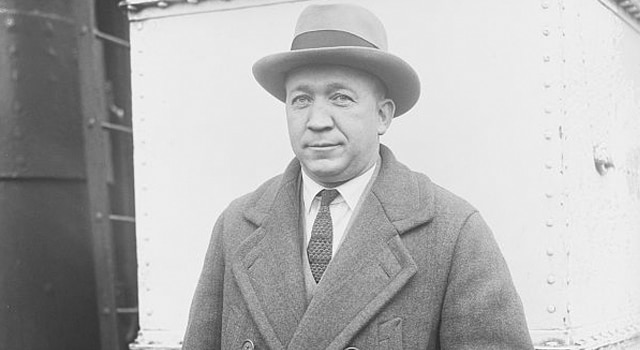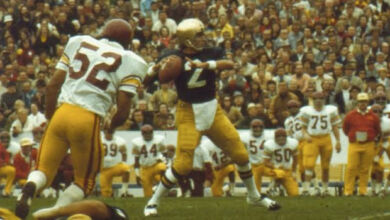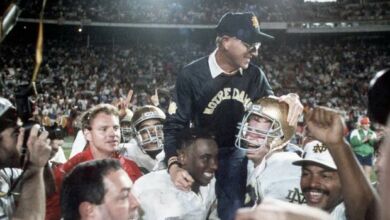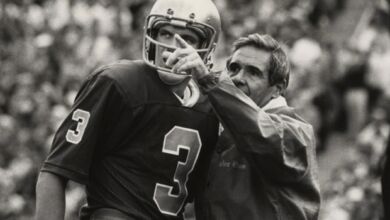

As the never-ending off-season finally draws close to ending, we continue to look back at great moments in Notre Dame football history to get everyone through the final few weeks until the Irish kick off the 2013 season. Last week we took a look back at the famed Four Horsemen of Notre Dame. Today, we take a look back on Notre Dame’s 1929 National Championship.
Win one for the Gipper – ’28 and the Gipper game
Knute Rockne’s Irish had finished the ’28 season with a 5-4 record. But that season was not without its moments. Rock had enjoyed the trip to the Rose Bowl after the Four Horsemen season of ’24 and Mrs. Rockne was even more enchanted by the lure of the West Coast.
So Rock had negotiated with the great Howard Jones, the coach at the University of Southern California, and they initiated college football’s first, greatest and most elegant intersectional rivalry. The Trojans had defeated the Irish 27-14 in Los Angeles, in 1928. But that was not the season’s most noteworthy event. That was, again, the Army-Notre Dame game in New York City, this one scheduled for glistening new Yankee Stadium, the house that Babe Ruth, for all practical purposes, built.
| 1929 Notre Dame Schedule | ||
| Date | Opponent | Result |
| 10/5/29 | @ Indiana | W, 14-0 |
| 10/12/29 | @ Navy | W, 14-7 |
| 10/19/29 | vs. Wisconsin * | W, 19-0 |
| 10/26/29 | @ Carnegie Mellon | W, 7-0 |
| 11/2/29 | @ Georgia Tech | W, 26-6 |
| 11/9/29 | vs. Drake # | W, 19-7 |
| 11/16/29 | vs. USC # | W, 13-12 |
| 11/23/29 | @ Northwestern | W, 26-6 |
| 11/30/1929 | @ Army | W, 7-0 |
| * Nuetral Site # Played at Solider Field in Chicago, IL |
||
You see the Irish were in trouble, behind 6-0 at halftime. Then came the most dramatic and celebrated moment in college football history.
With glistening eyes, and a tremor in his voice, Rock addressed his team with just minutes left in the halftime break:
Rock told them of George Gipp, Notre Dame’s larger than life first All American, who while he was on his deathbed, spoke with Rock who was at his side. Disease had robbed Gipp of his strength and vigor, but not of his courage, not of his soul, and not of his love for Notre Dame..
There in the Yankee Stadium locker room Rockne repeated, VERBATIM, Gipp’s dying words:
“I’ve got to go, Rock. It’s all right, I’m not afraid. Rock when the team is up against it. when things are wrong and the breaks are beating the boys,
ask them to go out there with all they’ve got and win just one for the Gipper. I don’t where I’ll be then, Rock, but I’ll know about it and I’ll be happy.”
Indeed! The Irish, adrenaline pumping, eyes focused like bee-bee’s tore out of the fancy new locker room at Yankee Stadium and on to the field of honor to fulfill the dying request of the great George Gipp!
With the Irish trailing 6-0 the fiery Jack Chevigny punched one into the end zone and shouted, with the goal line chalk still flying: “That’s one for the Gipper.”
At Notre Dame we have so many legends, that there was a second one in this game. A speedster from Los Angeles named Johnny O’Brien had become a track star and held the world record for the 60 yard hurdles. He was on the football team, but seldom played. He was on the bench for the whole game, until, in an inspired moment, Rockne turned to the fleet Jonny,and with the score 6-6 sent his speedster onto the field. Nice call, there, Rock. The ball was snapped, the quarterback retreated and threw it in the general vicinity of Johnny O’Brien Johnny loped under the ball caught it and , quite literally, sprinted into the end zone for the final 12-6 margin.
So on the day that the irish won one for the Gipper, Johnny O’Brien made that ONE PLAY that ever after labeled him Johnny “One Play” O’Brien.
Jimmy Breslin wrote about the impact of the Gipper-inspired victory: “When the Daily News hit the streets a few hours later”-New York morning papers put out a late night edition at the time- “the story of George Gipp became an American legend as common to the American sports fan as as a fairy tale is familiar to a sleepy-eyed youngster The Gipp myth gained fantastic momentum through an era of sportswriting that saw athletes likened in print to Greek Gods. Out of this came the legend of “the Gipper.”
Notre Dame Football 1929 – Road Warriors
In 1929 Rockne confronted a “minor” issue that would have broken lesser men. Because the Notre Dame stadium, modeled after the ovoid colossus in Ann Arbor, was being built, the Irish would have no home games. Rock brushed away that fact as if it were a mosquito. He had other tasks. His defense had given up 107 points in ’28 and Rock was not going to allow that in ’29.
The Irish opened against Indiana in Bloomington and shut out the Hoosiers, 14-0. It would be the ONLY game the Irish would play in Indiana for the whole year. The Irish then trekked to Baltimore and beat Navy, 14-7. Notre Dame then went to its second home in Soldier Field and bested Wisconsin, 19-0. On the last Saturday in October the Irish traveled to Pittsburgh to confront a Carnegie-Mellon squad that trounced the Irish 27-7 in ’28 in South Bend. But the Irish shut out the Tartans, 7-0. The Irish finished October unbeaten and had given up only that single touchdown to Navy.
Rock had given Jack Chevigny a job as an assistant coach, and the fiery Chevigny warmed to the task. He told Jumpin’ Joe Savoldi:
“Keep on going, Joe! Don’t stop when you are tackled! Keep those legs going. Don’t stop even when you are on the ground with half of the other team on top of you. Keep on going until you can’t wiggle a toe! Don’t stump until the referee takes the ball from you! Keep on going! Keep on going!”
Frank Carideo was the Irish quarterback. Many felt he was the trickiest, most deceptive ball handler of his era. Marchy Schwartz was the swivel-hipped halfback from the Deep South and Bay St. Louis, Mississippi. One of the offensive linemen was from Winner, South Dakota. His name was Frank Leahy, and he was absorbing every bit of technical and motivational knowledge he could from Knute Rockne. Jack Cannon was the bellwether of the line and was on his way to joining Carideo as a first team All American.
Bear Market in stocks, not Notre Dame football
The Monday following the Carnegie-Mellon game is now known as “Black Monday” and the succeeding day is called “Black Tuesday.” The due bills for the speculative frenzy of the 20’s were presented, and the market crashed, losing 25% of its value in just those two days. Panic selling on Black Tuesday created a sales volume record that lasted for forty years. The market had peaked in September, 1929 and would not reach a new high until 1954, or in Notre Dame clock-speak, until after Leahy was no longer the ND coach.
Now THAT is a bear market.
Rockne did not let it distract him or his team. They prepared for the trip to Atlanta to meet the Yellow Jackets, the Engineers, the Ramblin’ Wreck, whichever identity Georgia Tech would don.
The Irish played their fifth game in five states against Georgia Tech in Atlanta handling the Yellow Jackets 26-6. The Irish then played three games in a row in Illinois. The first was against Des Moines’ Drake in Soldier Field. The Irish racked up their 6th win, 19-7. Then came the season’s defining game against Jones and his Trojans. The Trojans had stumbled against Cal, 15-7, but otherwise dominated their West coast foes. having romped over UCLA, Washington and Stanford by a total of 131-0. For that era, the Trojans were a scoring machine.
Notre Dame won 13-12 in a grueling contest in massive Soldier Field. Soldier Field was bigger in those days and in 1927 120,000 fans had attended the USC-Notre Dame football game.
The Irish were now recognized as the top team in the land, but there was some unfinished business.
The Irish returned to Chicagoland the following Saturday and handled business against a solid 6-2 Northwestern squad in Evanston. The Irish won comfortably 27-6.
Only one game remained. The Irish had beaten the best of the West Coast, USC, a slew of midwestern teams and now had to face the final Eastern obstacle, Army, once again in New York City. The Long Gray Line still smarted over the “Gipper” game the year before, but the Irish notched their fourth shutout of the year, 7-0.
The Irish stood alone at 9-0 and while the offense had amassed only 145 points it was quite enough with the mere 38 points yielded to the opponents.
Purdue and Pitt had finished unbeaten but the Irish had played the more difficult schedule. The Irish were the 1929 National Champions
Joining Carideo and Jack Cannon on the all America team was the wondrously named Bronko Nagurskii of Minnesota. He too would have an award named after him Notre Dame’s championship was doubly significant.
First, the irish did something that had never been done before and probably never will be again. Notre Dame was unbeaten and NEVER PLAYED A HOME GAME.
Second, some skeptics, and yes, Virginia, they existed back then, even 90 years ago, had regarded Notre Dame’s ’24 National Championship as a fluke, a testimony to Granny Rice and the colorful Four Horsemen as much as anything else. And those venomous critics clucked gleefully from ’25-’28 when the Irish were a “mere” 28-8-2. But the ’29 championship proved that Notre Dame was a serious force, and in a concept which had not yet been crystallized into its familiar modern nomenclature, a “Program.”
Knute had his second! Could he do it again?
Go Irish!




Tex, thank you, but the article was actually written by one of our other writers but got labeled wrong in our publishing software. Can you send over more details on the newsletter through our contact form? https://www.uhnd.com/contact/
Frank…
Great story on the 1929 Notre Dame National Championship team. I always enjoy reading early college football history and without a doubt, the Irish sure know how to make it.
I publish a newsletter on historical college football and would like to invite you to become a subscriber–it’s free.
The College Football Historian is published the first Saturday of each month and sent bcc via email to over 530 subscribers, world-wide.
I would like your permission to run this story in a future issue (also the one on the Four Horsemen.)
Continue the awesome writing and research.
What a great telling of the truth, Notre Dame football is what football is all about. GO IRISH